A monthly e-newsletter from UMass Extension for landscapers, arborists, and other Green Industry professionals, including monthly tips for home gardeners.
To read individual sections of the message, click on the section headings below to expand the content:
Financial Assistance Available for GREEN SCHOOL
Green School is our comprehensive 12-day certificate short course for Green Industry professionals taught by UMass Extension Specialists, University of Massachusetts faculty, and guest presenters. For eligible employers in Massachusetts, the registration fee may be partially reimbursed (up to 50%) through the Massachusetts Workforce Training Fund Express Grant Program. Employers should submit an online application to the Express Grant program at least 4 weeks in advance of Green School's starting date. To find out if you qualify and to apply for benefits, go to http://workforcetrainingfund.org/apply/express-program/.
Classes begin October 26, but the early-bird registration rate ends September 15!
Where: Green School is going VIRTUAL for 2020!
 Every two years, UMass Extension offers its popular Green School, a comprehensive 12-day certificate short course for Green Industry professionals taught by UMass Extension Specialists, University of Massachusetts faculty, and guest presenters. This course will not be offered again until 2022.
Every two years, UMass Extension offers its popular Green School, a comprehensive 12-day certificate short course for Green Industry professionals taught by UMass Extension Specialists, University of Massachusetts faculty, and guest presenters. This course will not be offered again until 2022.
Instruction in 2020 will be 100% virtual, providing attendees with online resources via an online learning management system, including a mixture of pre-recorded lectures, live lectures via Zoom and GoToWebinar, and live guided discussions/Q&A opportunities that compliment pre-recorded lecture material via Zoom.
THREE SPECIALTY TRACKS ARE OFFERED - Landscape Management, Turf Management, and Arboriculture
PRE-REGISTRATION IS REQUIRED, as space is limited! The early-bird rate ends Sept. 15. Registration deadline: October 15.
Find the full schedule and registration info at: http://ag.umass.edu/greenschool
Featured Plant
Hairy toad lily (Tricyrtis hirta)
With such a humble name, you’d be forgiven in thinking that the hairy toad lily (Tricyrtis hirta) is worth little more than a passing glance. However, this gem, with its speckled, orchid-like blossoms, is undoubtedly deserving of a place in the pantheon of outstanding fall perennials. The plant is not new to the market, but is notably absent in so many of the gardens I visit as a landscape professional. Fortunately, it is usually love at first sight for clients introduced to toad lily in bloom.
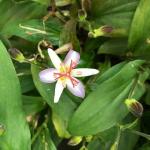 Flower Power
Flower Power
Toad lily’s flowers are tiny wonders, best suited for areas where they can be viewed at close range. Those of hairy toad lily are visible now. Beginning late summer and continuing until they are hit by frost, the inch-wide blossoms consist of 6 colorful tepals (similar-looking petals and sepals) arranged in a star-like pattern. Most often, hairy toad lily flowers are white or pale purple and covered with dark purple spots reminiscent of orchids. They occur alone or in groups of 2 to 3 along the upper parts of the plant, anywhere from 1 to 3 feet from the ground. Toad lily flowers are magnets for butterflies, bees, and other insects.
When the plant is not in bloom, its foliage can also offer ornamental interest. Hairy, parallel-veined, oval leaves with pointed tips and clasping bases are arranged alternately along the equally hairy stems. In the species, leaves are an attractive solid green, but variegated selections such as ‘Albomarginata’ are also available.
The Right Site
The genus Tricyrtis is a group of approximately 20 species in the Lily family, native to parts of Asia. Its wide range, from mountainous regions like the Himalayas to more tropical climes, means that toad lily’s hardiness is similarly varied. Hairy toad lily is hardy to zone 4, while Tricyrtis formosana and some of the other commercially available selections are less hardy (zone 6). Toad lily is generally found growing in the wild in woodland sites (at forest edges, along streambanks, and on shaded slopes) and performs best in gardens with similar conditions. The plant thrives in part- to full shade and moist, slightly acidic soil with plenty of organic matter. Mulching can help maintain consistent soil moisture. While toad lily can reportedly tolerate some soil drying once established, it responds to prolonged drought conditions with brown-edged, spotted leaves and fewer (if any) flowers.
In addition to drought, other threats to toad lily in the garden include slugs, snails, and rabbits, all of which like to feed on the young leaves. Some plants may be susceptible to anthracnose leaf spot, but refraining from overhead watering, improving air circulation around plants, and removing infected leaves and stems can help address this fungal disease. Monitor plants regularly for aphids, as they can spread Tricyrtis floral virus, which causes flower discoloration.
Aside from these few inconveniences, hairy toad lily is relatively low maintenance and works well in plantings with other shade-lovers such as ferns, hostas, astilbes, and anemones. It spreads slowly via rhizomes and may occasionally self-sow. Plants can be propagated by division in early spring, early summer stem cuttings, or seeds.
If the shade garden is missing some autumn pizzazz, hop on out and pick up a few hairy toad lilies to jump start the landscape.
Jennifer Kujawski, Horticulturist
Questions & Answers
Q. What can I do to manage apple scab on landscape apples/crabapples?
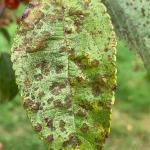 A. Apple scab, caused by the fungal pathogen Venturia inequalis, is a pervasive foliar disease of apple/crabapple trees in the landscape. Infections can result in early season leaf defoliation and contribute to decline when other stresses are present. While many new Malus cultivars are resistant to apple scab, older cultivars and varieties are generally quite susceptible to infection. Venturia overwinters on infected, discarded leaves and in the spring, the fungus produces spores that can travel up to 100’ away to infect newly developing leaves. After this initial infection period, the fungus can reinfect new leaves in the canopy whenever conditions for sporulation allow (mild and wet). Therefore, eliminating the infected leaves in autumn or the following spring, before trees flush new growth, is very important to reduce disease pressure. Mowing discarded leaves can accelerate their decomposition but removal (vacuuming or raking) will be more effective in eliminating this inoculum source. For landscapes where mowing or leaf removal is difficult, applying a urea solution to the discarded leaves can aid in decomposition.
A. Apple scab, caused by the fungal pathogen Venturia inequalis, is a pervasive foliar disease of apple/crabapple trees in the landscape. Infections can result in early season leaf defoliation and contribute to decline when other stresses are present. While many new Malus cultivars are resistant to apple scab, older cultivars and varieties are generally quite susceptible to infection. Venturia overwinters on infected, discarded leaves and in the spring, the fungus produces spores that can travel up to 100’ away to infect newly developing leaves. After this initial infection period, the fungus can reinfect new leaves in the canopy whenever conditions for sporulation allow (mild and wet). Therefore, eliminating the infected leaves in autumn or the following spring, before trees flush new growth, is very important to reduce disease pressure. Mowing discarded leaves can accelerate their decomposition but removal (vacuuming or raking) will be more effective in eliminating this inoculum source. For landscapes where mowing or leaf removal is difficult, applying a urea solution to the discarded leaves can aid in decomposition.
Pruning the tree can also be an important management strategy. Apple and crabapple produce abundant suckers on interior canopy branches. If these shoots are heavily shaded, they are highly susceptible to infection. In addition, a dense canopy reduces air flow, which in turn allows moisture to linger. Prune to retain branches that receive as much sun as possible, removing interior branches that are in deep shade. Typically, pruning also creates a more aesthetically appealing tree and will improve air flow through the canopy. If chemical management is desired, first determine whether or not fruit will be harvested for consumption. Many fungicides labeled for use should not be used if the fruit will be eaten. Fungicide applications should take place as new growth is developing, as this is the time when new foliage is most susceptible to the primary infection. Carefully check the label or consult with your managing arborist/landscaper. Fungicides labeled for use include: captan, mancozeb, copper-based products (e.g. copper hydroxide), myclobutanil and tebuconazole. With thorough leaf removal and pruning to improve light and air flow, fungicides may not be required.
For more information, see the following fact sheet: https://ag.umass.edu/landscape/fact-sheets/apple-scab
Nick Brazee, UMass Extenstion Plant Pathologist
Trouble Maker of the Month
September is Tussock Time
Every year around this time, at least a handful of questions come in about hairy caterpillars. By September, various species of tussock moths (Family: Erebidae, Subfamilies Lymantriinae and Arctiinae) have mature caterpillars that garner a lot of attention due to their colorful and hairy appearance. The following are a few (but not all) examples:
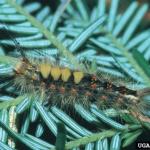 The rusty tussock moth (Orgyia antiqua) may be found in woodlands, fields, and forests in New England with mature caterpillars present in August and September. This species is a generalist feeder. Host plants include alder, apple, cherry, elm, fir, hemlock, larch, maple, oak, pine, poplar, spruce, viburnum, and willow, among others. Mature caterpillars have a jet black stripe down the dorsal side, four straw-colored tufts of hair, and bright red warts.
The rusty tussock moth (Orgyia antiqua) may be found in woodlands, fields, and forests in New England with mature caterpillars present in August and September. This species is a generalist feeder. Host plants include alder, apple, cherry, elm, fir, hemlock, larch, maple, oak, pine, poplar, spruce, viburnum, and willow, among others. Mature caterpillars have a jet black stripe down the dorsal side, four straw-colored tufts of hair, and bright red warts.
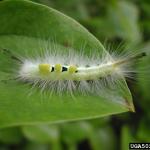 The definite tussock moth (Orgyia definita) are also found in fields, woodlands, and forests in New England, but caterpillars may be present from April to September. Another generalist, caterpillars will feed on the foliage of basswood, birch, blueberry, elm, hackberry, maple, oak, willow, witch hazel, and other woody plants. This particular species is usually quite common. Caterpillars are mostly bright yellow with cream to yellow tufts of hair and a colorless or grey dorsal stripe and yellow warts.
The definite tussock moth (Orgyia definita) are also found in fields, woodlands, and forests in New England, but caterpillars may be present from April to September. Another generalist, caterpillars will feed on the foliage of basswood, birch, blueberry, elm, hackberry, maple, oak, willow, witch hazel, and other woody plants. This particular species is usually quite common. Caterpillars are mostly bright yellow with cream to yellow tufts of hair and a colorless or grey dorsal stripe and yellow warts.
 The white-marked tussock moth (Orgyia leucostigma), found in the same habitats as the previous two species, can have caterpillars present in New England until November. This generalist feeder uses apple, birch, black locust, cherry, elm, hackberry, hickory, oak, rose, willow, fir, hemlock, larch, spruce, and other conifers as hosts. Caterpillars have a bright red head, four white – yellow tufts of hair, a black dorsal stripe surrounded by yellow dorsal stripes on either side, with red glands elsewhere on the body. These caterpillars can be occasional pests of Christmas tree plantings. The white-marked tussock moth, like many tussock moth caterpillars, may cause allergic reactions in certain individuals if their hairs come into contact with sensitive areas of the skin.
The white-marked tussock moth (Orgyia leucostigma), found in the same habitats as the previous two species, can have caterpillars present in New England until November. This generalist feeder uses apple, birch, black locust, cherry, elm, hackberry, hickory, oak, rose, willow, fir, hemlock, larch, spruce, and other conifers as hosts. Caterpillars have a bright red head, four white – yellow tufts of hair, a black dorsal stripe surrounded by yellow dorsal stripes on either side, with red glands elsewhere on the body. These caterpillars can be occasional pests of Christmas tree plantings. The white-marked tussock moth, like many tussock moth caterpillars, may cause allergic reactions in certain individuals if their hairs come into contact with sensitive areas of the skin.
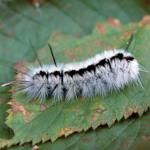 Another commonly seen caterpillar this time of year is the hickory tussock moth (Lophocampa caryae). Caterpillars may be present in July, August, and September. Host plants include birch, quaking aspen, basswood, and black locust, among others. Caterpillars are mostly white, with a black stripe down the back and sporadic longer black hairs or “pencils”. The hairs from the hickory tussock moth can also cause allergic reactions in some individuals.
Another commonly seen caterpillar this time of year is the hickory tussock moth (Lophocampa caryae). Caterpillars may be present in July, August, and September. Host plants include birch, quaking aspen, basswood, and black locust, among others. Caterpillars are mostly white, with a black stripe down the back and sporadic longer black hairs or “pencils”. The hairs from the hickory tussock moth can also cause allergic reactions in some individuals.
While these native caterpillars do not typically reach densities that cause defoliation and dieback of their host plants, occasional outbreaks can occur. In the meantime, a good rule of thumb for interacting with hairy caterpillars is to give them their space. While not all hairy caterpillars cause allergic reactions in all people, some can cause particularly severe reactions. Examples include the browntail moth (Euproctis chrysorrhoea) and flannel moth species in the Family Megalopygidae, among others. Therefore, exercise caution and resist the urge to pet hairy and fuzzy looking caterpillars when you see them.
Looking for more information about the beautiful caterpillars that call Massachusetts home? A great guide to some of our most common species is Caterpillars of Eastern North America by David L. Wagner (2005).
Tawny Simisky, Extension Entomologist, UMass Extension Landscape, Nursery, & Urban Forestry Program
Garden Clippings Tips of the Month
September is the time to:
- Beware of yellow jackets and bald-faced hornets. In late summer and early fall, yellow jackets and bald-faced hornets become more prevalent as their nests reach maximum size and foraging habits change from a protein rich diets of insects to a diet of carbohydrates and sugars. This change in diet results in attraction to the foods we eat and causes them to be nuisances when eating outdoors or when they are attracted to potential food sources like dumpsters. While both yellow jackets and bald-faced hornets can deliver powerful stings, rarely do they sting when far away from the nest. As gardeners' or landscape professionals' awareness of nests is important, take a minute or two to scan an unfamiliar area before working in it for possible nesting locations. Yellow jackets typically nest in the ground in old rodent burrows and favor areas like rock walls and similar structures, whereas bald faced hornets produce aerial nests in dense trees and shrubs or in the eaves of buildings and sheds. Spending an extra minute or two to explore an area for nests can save you from a potentially painful experience.
- Renovate and repair damaged lawns. The droughty conditions of summer have left many lawns with damaged turf that is unlikely to recover. Repair damaged turf by raking and spreading seed before weeds get established. Renovate a lawn by aerating, overseeding, dethatching, and liming if necessary. Don’t forget this is also the most important time to feed a cool season lawn. The efforts put into a lawn now are well worth it and will result in a vigorous lawn next spring.
- Change up container plants. By late summer, many flowering containers look overgrown and worn out. Swap the summer plants out for something that will thrive under the cool conditions of fall. Asters, chrysanthemums and flowering cabbage and kale are some of the most common options for autumn displays. Other options include ornamental grasses, heuchera, sedum or cool season annuals like alyssum, dusty miller and pansies.
- Build a compost pile. Now is the time to prepare for the large influx of leaves that is soon to come. Instead of hauling all the leaves away, compost onsite and make a valuable soil amendment for use in the future. Planning a new garden or bed? Build the compost pile where the garden or bed will be, which will make it easy to spread out the compost. To make a good aerobic compost, use a general recipe of 3:1 browns to greens. Browns represent materials high in carbon like leaves; greens represent materials high in nitrogen like kitchen scraps. Keep the pile moist and turned for faster composting.
- Plant. September is a great time to plant ornamentals as air temperatures are cool and soils tend to be moist and still warm. Give plants about 4-6 weeks to establish prior to consistent frosts and/or when the soil begins to freeze. Mulch the root zones of fall planted ornamentals with 3-4” of mulch over the root zone (none at the trunk) to reduce the likelihood of frost heaving.
- Prepare houseplants for the return indoors. Tropical plants and other indoor plants that spend the summer outside should be brought in when nighttime low temperatures are regularly in the 50s. Before bringing plants inside, make sure the plants are in good health and check for unwanted pests. Whiteflies and aphids are two common insects that typically accompany plants when brought indoors. Use an insecticidal soap or similar insecticide before bringing plants indoors to reduce harboring unwanted pests.
Russ Norton, Agriculture & Horticulture Extension Educator, Cape Cod Cooperative Extension
Are Crops in the US Pollination Limited?
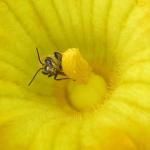 Many food crops – especially high-value fruits and vegetables – depend on pollinators for fruit production and seed set. At the same time, pollinators are less abundant: yearly honey bee losses remain high and many wild bee species are in decline. This begs the question: could yields be limited by insufficient pollination? And how important are wild bees (as opposed to honey bees) for crop pollination? Past studies have tested the effect of insufficient pollination on wild plants; surprisingly few have focused on crops. Recently a multi-university group carried out a national study looking at seven key crops across the US – almond, apple, blueberry, sweet cherry, tart cherry, pumpkin, and watermelon. They monitored pollinator visits to target farms in key growing regions, as well as available blossoms and final yield. They used that information to estimate the proportion of pollination that was performed by wild bees and to test for yield loss due to insufficient pollination. They found that the apples, blueberries, sweet cherries and tart cherries were pollination limited. They also discovered that wild bee visitation varied by crop: pumpkins were overwhelmingly pollinated by wild bees (74.6% of visits), while almonds were pollinated exclusively by honey bees (100% of visits). Overall, wild bees performed about 26% of pollinator visits. The authors estimate the value of wild bees to the economy at $1.5 billion across all target crops except almonds. The economic value of honey bees across these crops totaled $2.2 billion.
Many food crops – especially high-value fruits and vegetables – depend on pollinators for fruit production and seed set. At the same time, pollinators are less abundant: yearly honey bee losses remain high and many wild bee species are in decline. This begs the question: could yields be limited by insufficient pollination? And how important are wild bees (as opposed to honey bees) for crop pollination? Past studies have tested the effect of insufficient pollination on wild plants; surprisingly few have focused on crops. Recently a multi-university group carried out a national study looking at seven key crops across the US – almond, apple, blueberry, sweet cherry, tart cherry, pumpkin, and watermelon. They monitored pollinator visits to target farms in key growing regions, as well as available blossoms and final yield. They used that information to estimate the proportion of pollination that was performed by wild bees and to test for yield loss due to insufficient pollination. They found that the apples, blueberries, sweet cherries and tart cherries were pollination limited. They also discovered that wild bee visitation varied by crop: pumpkins were overwhelmingly pollinated by wild bees (74.6% of visits), while almonds were pollinated exclusively by honey bees (100% of visits). Overall, wild bees performed about 26% of pollinator visits. The authors estimate the value of wild bees to the economy at $1.5 billion across all target crops except almonds. The economic value of honey bees across these crops totaled $2.2 billion.
Why is this research important?
This study found that wild bees provide substantial agricultural pollination services, and that several large-scale crops in the US may be limited by a lack of pollinators. It provides clear support for the need to preserve and attract native bees in agricultural areas.
Read the full study here: https://royalsocietypublishing.org/doi/suppl/10.1098/rspb.2020.0922
Plant Composition Affects Bumble Bee Pathogens
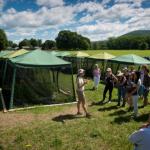 In order to support bee health, advocacy groups have encouraged planting floral strips along agricultural fields, roads, and residential areas. In addition to providing food however, these flowers can be hubs of bee disease transmission. Recently, researchers from Lynn Adler’s lab at UMass Amherst tested the impact of different floral mixes on bumble bee reproduction and gut pathogens. The lab had previously shown that certain flowers increase or decrease bumble bee gut infections in the lab (read more here). In this study, they assembled three groups of outdoor tents and filled them with various potted plants: (1) canola only (a pollinator-dependent crop), (2) canola and a high-transmission flower mix (based on the earlier lab study), and (3) canola and a low-transmission flower mix. They then placed bumble bee microcolonies in the tents for 2-week intervals and monitored bee disease and colony reproduction. They found that bees in tents with high-transmission flowering strips had double the infection intensity of those in low-transmission tents. However, colony reproduction was improved in tents with any flowering strip, compared to those with only canola.
In order to support bee health, advocacy groups have encouraged planting floral strips along agricultural fields, roads, and residential areas. In addition to providing food however, these flowers can be hubs of bee disease transmission. Recently, researchers from Lynn Adler’s lab at UMass Amherst tested the impact of different floral mixes on bumble bee reproduction and gut pathogens. The lab had previously shown that certain flowers increase or decrease bumble bee gut infections in the lab (read more here). In this study, they assembled three groups of outdoor tents and filled them with various potted plants: (1) canola only (a pollinator-dependent crop), (2) canola and a high-transmission flower mix (based on the earlier lab study), and (3) canola and a low-transmission flower mix. They then placed bumble bee microcolonies in the tents for 2-week intervals and monitored bee disease and colony reproduction. They found that bees in tents with high-transmission flowering strips had double the infection intensity of those in low-transmission tents. However, colony reproduction was improved in tents with any flowering strip, compared to those with only canola.
Why is this research important?
This study found that flowering strips improved bee reproduction, regardless of flower composition. However, certain floral mixes also increased infection intensity. The researchers don’t know why some plants led to higher or lower infection; future research will explore factors like floral architecture, plant volatiles, and nectar chemistry. Understanding how plants affect bee disease is important because it could help us to design optimal planting mixtures for flowering strips.
Read the full study here: https://www.pnas.org/content/117/21/11559
Hannah Whitehead, UMass Extension Honey Bee Educator
Upcoming Events
For more details for any of these events, go to the UMass Extension Landscape, Nursery, and Urban Forestry Program Upcoming Events Page.
-
Dec 2 - Fall Wrap-Up for Landscapers
Live webinar - details coming soon! -
Dec 4 - Fall Wrap-Up for Turf Managers
Live webinar - details coming soon!
Green School
Classes will be held vitually 10/26 to 12/10. For more details and registration info, go to https://ag.umass.edu/landscape/education/umass-extensions-green-school.
- Sept 15 - Early-bird registration ends!
- Oct 15 - Deadline for receipt of applications.
Tune in to a TickTalk with TickReport Webinars
This is a FREE live webinar series by Dr. Stephen Rich, Director of the UMass Laboratory of Medical Zoology held noon to 1:00 pm on the 2nd Wednesday of the month. Co-sponsored by UMass Extension and the UMass Laboratory of Medical Zoology. Register at https://ag.umass.edu/landscape/education-events/webinars
- Sept 9 - Biology of Ticks and Other Tick-Borne Disease
Speaker: Daniel Sonenshine, Professor Emeritus, Old Dominion University; Laboratory of Malaria and Vector Research, National Institute of Allergy and Infectious Disease (NIH)
Dr. Rich will host Dr. Daniel Sonenshine, preeminent tick biologist who quite literally wrote the book on ticks (Biology of Ticks in two volumes, co-authored with Dr. R. Michael Roe). Dr. Sonenshine’s research interest in ticks precedes the discovery of Lyme disease in North America and he is thus uniquely qualified to provide a historical context for this public health challenge. - Oct 14 - Tick-borne Disease Surveillance in the US
Speaker: Dr. Ben Beard, Deputy Director, Division of Vector-Borne Diseases, Centers for Disease Control and Prevention (CDC)
Dr. Rich welcomes Dr. Ben Beard to the TickTalk webinar. Dr. Beard will present the latest CDC findings on the burdens of tick-borne disease and public health trends. -
Nov 18 - Babesiosis
Speaker: Dr. Sam R. Telford III, Professor, Cummings School of Veterinary Medicine at Tufts University
Dr. Telford III joins Dr. Rich on the TickTalk webinar to discuss the second most commonly reported tick-borne disease in North America (after Lyme disease). Babesiosis is a malaria-like illness transmitted by the same ticks as Lyme. Dr. Telford is recognized as a global authority on this disease.
Pesticide Exam Preparation and Recertification Courses
These workshops have been converted to a remote/online format. Contact Natalia Clifton at nclifton@umass.edu or go to https://www.umass.edu/pested for more info.
Invasive Insect Webinars
Find recordings of these webinars at https://ag.umass.edu/landscape/education-events/invasive-insect-webinars. Topics include the spotted lanternfly, spotted wing drosophila, brown marmorated stink bug, emerald ash borer, gypsy moth, winter moth, and Asian longhorned beetle.
InsectXaminer!
Episodes so far featuring gypsy moth, lily leaf beetle, euonymus caterpillar, and imported willow leaf beetle can be found at: https://ag.umass.edu/landscape/education-events/insectxaminer
Additional Resources
For detailed reports on growing conditions and pest activity – Check out the Landscape Message
For commercial growers of greenhouse crops and flowers - Check out the New England Greenhouse Update website
For professional turf managers - Check out our Turf Management Updates
For home gardeners and garden retailers - Check out our home lawn and garden resources. UMass Extension also has a Twitter feed that provides timely, daily gardening tips, sunrise and sunset times to home gardeners at twitter.com/UMassGardenClip
Food Gardening in Massachusetts 2020
With the uncertainties around the Coronavirus (COVID-19) and the economy, growing your own food is appealing as a way to help alleviate food insecurity, do something fun that is compatible with social distancing, and produce healthy and nutritious food! To become a successful gardener is not complicated; for the most part, the needed skills can be easily mastered. Join us for this series of weekly articles which with provide research-based information on how to grow your own vegetables and herbs in Massachusetts.
Some of the content has been adapted from the New England Vegetable Management Guide, a collaborative effort by members of the Extension Vegetable Programs of the New England states. These articles are written by Frank Mangan, Extension Professor of Vegetable Crops at the UMass Stockbridge School of Agriculture, and his Ph.D. student, Heriberto Godoy Hernandez, and are available in both English and Spanish. Additional expertise on specific topics is provided by UMass Extension Specialists.
Growing Your Own Food with Franco and Beto (Columna de Franco y Beto sobre el cultivo de sus propias hortalizas y hierbas aromáticas en Massachusetts) is available here: https://ag.umass.edu/resources/home-lawn-garden/food-gardening-in-massachusetts-2020
Diagnostic Services
Landscape and Turf Problem Diagnostics - The UMass Plant Diagnostic Lab is accepting plant disease, insect pest and invasive plant/weed samples (mail-in only - walk-in samples cannot be accepted). The lab serves commercial landscape contractors, turf managers, arborists, nurseries and other green industry professionals. It provides woody plant and turf disease analysis, woody plant and turf insect identification, turfgrass identification, weed identification, and offers a report of pest management strategies that are research based, economically sound and environmentally appropriate for the situation. Accurate diagnosis for a turf or landscape problem can often eliminate or reduce the need for pesticide use. Please refer to our website for instructions on sample submission and to access the submission form at https://ag.umass.edu/services/plant-diagnostics-laboratory. Mail delivery services and staffing have been altered due to the pandemic, so please allow for some additional time for samples to arrive at the lab and undergo the diagnostic process.
Soil and Plant Nutrient Testing - The UMass Soil and Plant Nutrient Testing Lab is accepting orders for routine soil analysis and particle size analysis ONLY (please do not send orders for other types of analyses at this time). Send orders via USPS, UPS, FedEx or other private carrier (hand delivered orders cannot be accepted at this time). Processing time may be longer than usual since the lab is operating with reduced staff and staggered shifts. The lab provides test results and recommendations that lead to the wise and economical use of soils and soil amendments. For updates and order forms, visit the UMass Soil and Plant Nutrient Testing Laboratory web site.
TickReport Update - The TickReport Risk Assessment & Passive Surveillance Program is open and tick samples can be submitted via https://www.tickreport.com. Please contact TickReport with with tick-related questions and updates on the status of their service.